The name of our writer has been changed to protect his identity.
***
During a dinner with Chinese friends, I asked the table, “Do you guys have friends in Xinjiang? I’m planning a trip there.” The lively vibe we had enjoyed turned into silence.
“Xinjiang? Don’t go there. It’s too dangerous. There’s all those Uyghurs with knives. Go to Hainan or something. It’s nicer there,” a friend cautioned.
“No, no, it used to be dangerous, but now it’s super safe. I have family there, they tell me there’s police everywhere now, nothing to worry about. It’s the safest place in China right now,” another friend said. She was trying to encourage me, in her own way, but it made me rather uneasy.
I then asked a third friend, who was playing with his phone and not paying that much attention. His lack of investment in the conversation struck me as a sign of impartiality.
“Oh, Xinjiang? 我不敢去 (I dare not go).”
‘Dare’ is not a perfect translation of 敢, but this wasn’t a statement of preference or lack of interest. He just isn’t brave enough to go. He expects trouble.
I’d always wanted to go. I speak the language well. I’ve traveled all over China and most countries in Asia. Xinjiang has been a big empty spot on my record. I had heard about the landscapes, the ruins, the museums. There were plenty of reasons to go to Xinjiang. And so it was time.
But I would be lying if I didn’t admit that the political situation was also part of my motivation. Recent media reports have been talking of one million people confined in “reeducation camps” all over the province, as well as a new high-tech surveillance system which maintains complete control of the population at all times. Foreign media broke the story last year, and since then, media attention had been slowly snowballing into a political issue, with foreign governments stating their concern about the situation in Xinjiang and accusing China of human rights abuses.
The last time tensions were this high over China’s handling of a minority population was in Tibet, and the result was the complete closure of Tibet to foreign travelers. You can still go there, but you need a special permit, which requires you to hire a local guide and basically be herded around like cattle. I like traveling freely without a guide, so I had to hurry to Xinjiang before some stupid white guy tries to be a hero, provokes the Chinese government, and this beautiful region gets the Tibet treatment.
Most media stories have been based on interviews of Uyghurs who aren’t exactly impartial when speaking about how the Chinese government treats them. I’m not saying they’re lying, but many of those interviewed are independence activists with a clear agenda. I thought it interesting to go check out the situation for myself. I’m not a journalist; I have no agenda. I love China, and I wish no ill on the Uyghurs. But I’m also a curious person. So I reached out to some friends, and bought tickets from Shanghai to Urumqi on China’s favorite travel app, Ctrip.
I must admit that I was completely paranoid about this trip. I tend to be paranoid in general, and the stories I was getting from Xinjiang weren’t helping my condition. The stories tell of widespread surveillance, foreigners being followed constantly, checkpoints everywhere, and most importantly, smartphones being checked for subversive apps. Well, I do have a lot of stuff on my smartphone, let alone my computer. So I bought a new phone just for the occasion and used all manner of opsec best practices.
Getting In
All prepared and in good (if somewhat uneasy) spirits, we arrived at Urumqi airport. I had mentally prepared myself for an entire police department waiting for us and rummaging through all our luggage, phones, and computers. I didn’t care. I Was Prepared. I was all pumped up for the occasion, rehearsing all the stories I had prepared to tell the local police.
And nothing happened. Nothing. Not even a miserly checkpoint in the whole airport. We just left the plane, got to domestic arrivals, picked up our luggage, and off we went. Just like any other airport in the free world. What the hell?
A government ad in the arrivals hall said: 新疆是个好地方. Xinjiang is a good place. Maybe they’re right. What if all those Western media reports were false or wildly exaggerated? It wouldn’t be the first time.
Somewhat spooked by the normality of the whole thing, we got in a taxi, told the driver our hotel address, and he very kindly started driving us to the city center. The driver asked where we were from and gave us some tourism tips. Everything was fine and friendly. We were overjoyed at the sight of a big, modern city, full of tall buildings and modern highways, all enclosed by the spectacular Tianshan mountains. Maybe Xinjiang really is a good place after all. An awesome place.

Then we got into the city and reality started to set in. The reports aren’t fake news. It’s all quite true.
The first thing that strikes you on arrival to Xinjiang, driving from the airport into the city, is the propaganda. It’s everywhere. It’s big. Huge banners and screens in every road, every street, singing the praises of the Communist Party and Xi Jinping, the Core Socialist Values, the 19th Congress, the China Dream, and so on and so forth. You have that all over China, and, to be honest, it’s gotten quite annoying over the last few years. But in Xinjiang, the density of propaganda banners is much higher. I didn’t count them, but I would say the propaganda signs and banners and advertising of all sizes were about five times as numerous as any big city in China.
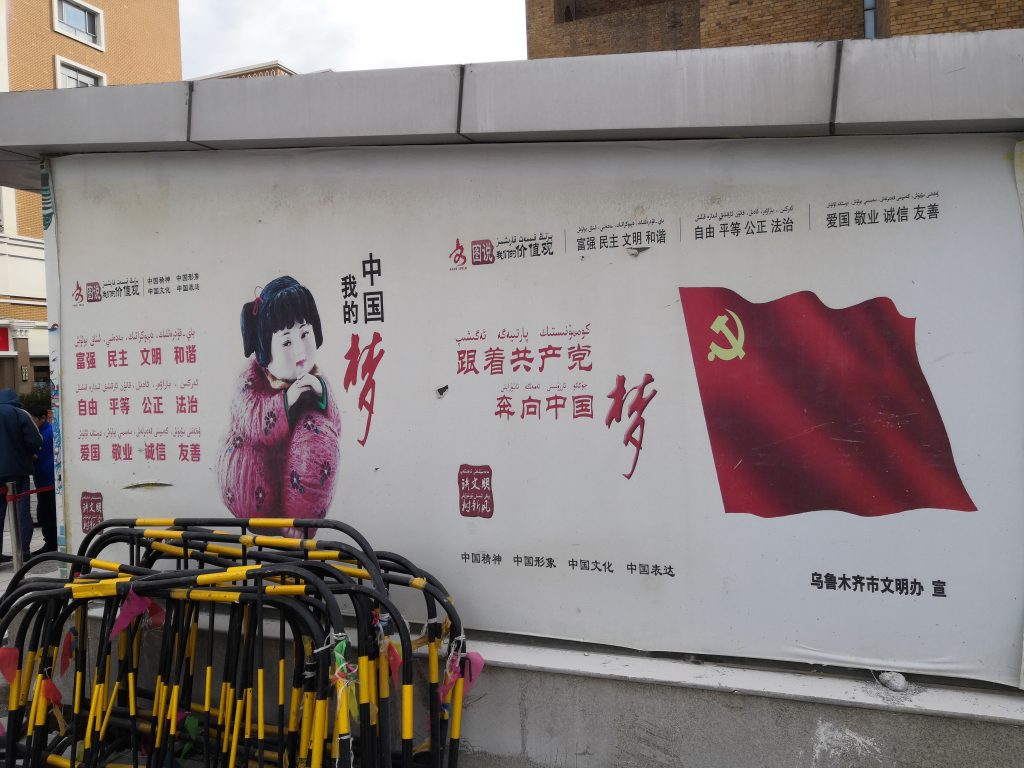
It’s also more in your face. In most of China, they are phasing out images of President Xi Jinping, since many were taken down after reported internal troubles this summer. That memo didn’t get to Xinjiang. His face and his name are everywhere. And they also have their own propaganda copy focused on ethnic relations. “All nationalities must unite together like the seeds of a pomegranate,” or “As grapevines are connected root by root, all Chinese nationalities are connected heart by heart.” It’s embarrassing, cheesy, and again, it’s everywhere. Probably engineered so that there is a piece of propaganda in your field of sight at every single moment. If Theodore Dalrymple were there (and could read Chinese), he’d go completely insane.
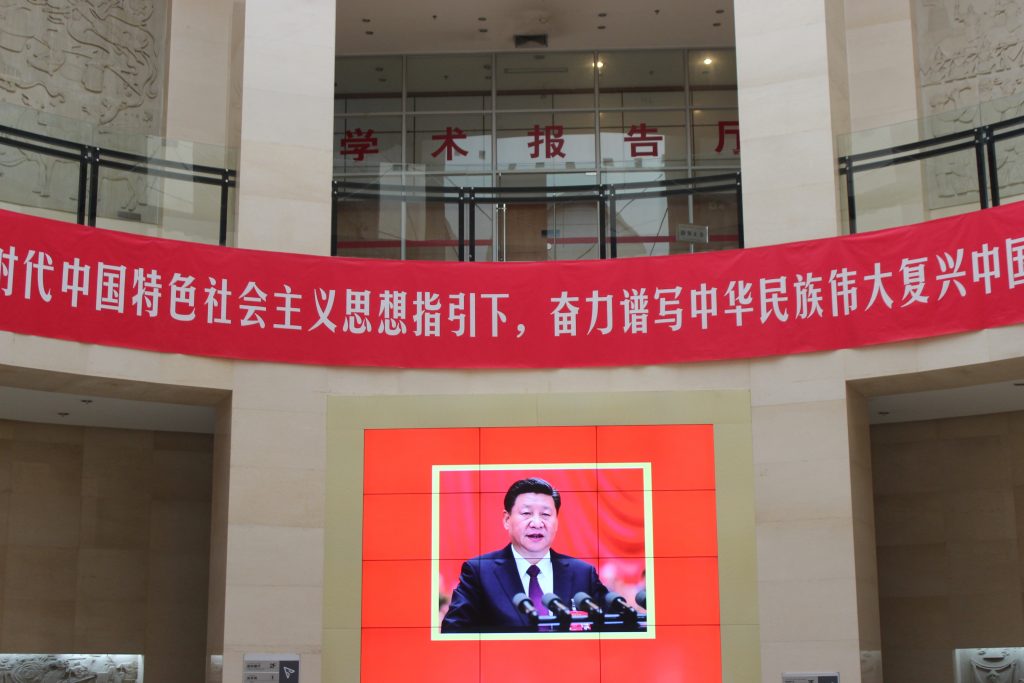
The other thing that is always in your field of sight is the police. Oh, the police. They are literally (literally) everywhere. If I had to guess, I’d say there’s a law that mandates a police station every 250 meters. The sheer amount of policemen, police cars, police checkpoints, police stations, and security guards of all sorts is completely overwhelming. I’ve never seen anything like it, and I don’t believe there is or ever has been. Xinjiang is a police state, and it’s open about it. Blatant. This is not a place where you worry about being watched. They watch you all the time, and they want you to know it.
While our taxi driver was cheerful, we were getting uneasy just looking through the windows. On arriving at our hotel, we stumbled upon another Xinjiang Characteristic. Shop checkpoints. The hotel had a small checkpoint with a metal detector, shields, and wooden bats in the floor. Two old men with police jackets were standing watch. They asked for our passports, took a clueless look, and waved us through. Check-in at the hotel was uneventful, the same procedure as everywhere in China.
We got our belongings ready and proceeded to go out for dinner, where we were to meet a local. One guy in our team had a business contact in Urumqi, and he offered to buy us a good Xinjiang dinner. We got in a taxi and arrived at the restaurant, where he was waiting for us in one of these booths with a couple of his friends. After the typical greetings and rounds of toasting (Chinese dinners are really tiresome), we ordered some food, and when the waiter left, he dropped this bomb on us:
“Do not, I repeat, do not talk politics, or ethnic relations stuff, or anything sensitive on the phone. Police know you’re here, your conversations are being listened to, your GPS is being recorded. If you do anything stupid on the phone, police will come in less than 30 minutes and take you away,” he said while looking me straight in the eye.
“What?”
“You heard me. Watch what you do on the phone.”
“Has this ever happened around you? You’ve seen this? Police taking people away because of what they said on the phone?”
“Oh, yes.”
I took a deep breath.
“How long has this been going on for?”
“A couple years, since the new guy came here.”
A waitress came in bringing our food. We all smiled and started eating, awkwardly changing the topic to sports. The food was great, we ate a lot, thanked our hosts profusely, and each went our own ways.
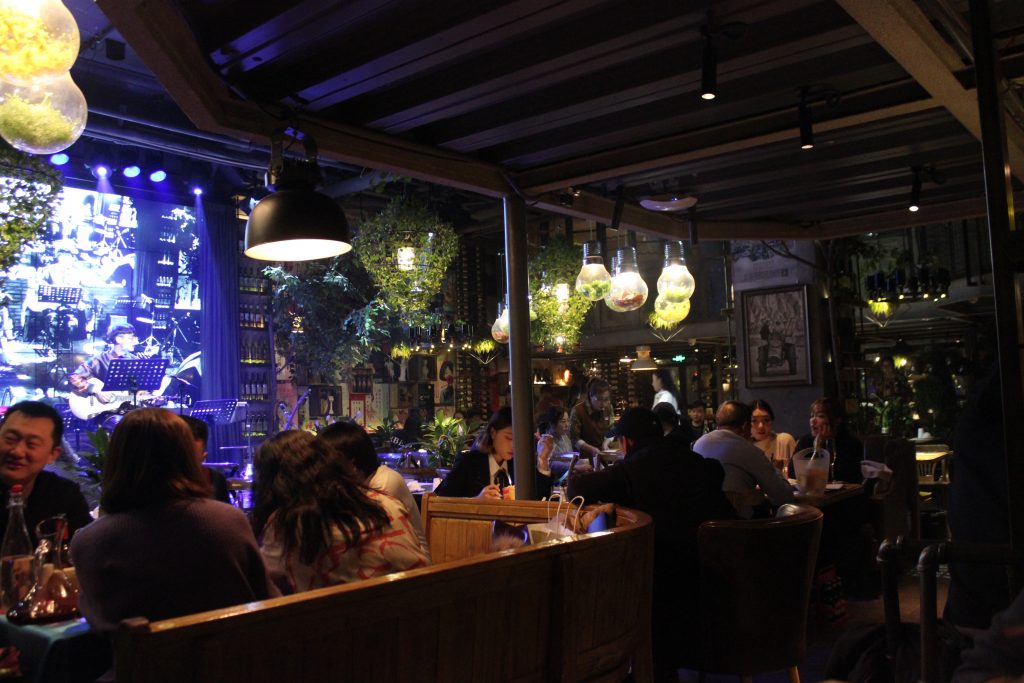
That admonition didn’t change anything. It didn’t catch us by surprise. We were all prepared, and besides, had no intention of getting in trouble. Our dinner hosts just made the risk sound so much more real. Don’t do anything sensitive or police will come in 30 minutes. Given the sheer amount of police we saw in the streets, that was probably a conservative estimate.
We went to sleep and prepared for what was to be a long trip.
Urumqi
Urumqi is the capital of the Xinjiang Uyghur Autonomous Region (XUAR, henceforth “the province”). It’s a big, modern and wealthy city of 3.5 million people, of whom 75% are Han Chinese, according to the latest census. The city is located just north of an opening in the Tianshan mountains, giving it a central and strategic location with access to the Tarim Basin south of it and the Dunzgar steppe to the north. This means two things: it’s just north of the mountains, so it’s cold. Very cold. And it’s also not by origin a Uyghur city, and its Uyghur population is barely a tenth of the total.
That didn’t stop the Chinese government from unleashing a high-tech triple-layer surveillance apparatus. We woke up the next morning and decided to just walk around the city, checking out the local spots and getting a feeling for the place. The first thing we realized is that Urumqi is actually pretty nice. It has any amenity you could wish for: coffee shops, restaurants, stores and shopping malls housing all manner of local and international chains. The people dress in stylish clothes and seem to be enjoying themselves. The city is clean and well-maintained, and the traffic, if a bit dense, is quite orderly. Far better than most provincial cities in China.
The second thing we realized is that the surveillance apparatus is hardcore. As I mentioned, there are police everywhere; standing, walking, and driving. They’re not aggressive, or intimidating, or stopping people at random. They’re just there making themselves present. They didn’t have guns; some had wooden bats, while others had fancy metal bats. There were tons of shields, too. This is the sort of anti-riot gear you see in a Western city when there’s any major gathering, or antifa are running one of their regular rituals.
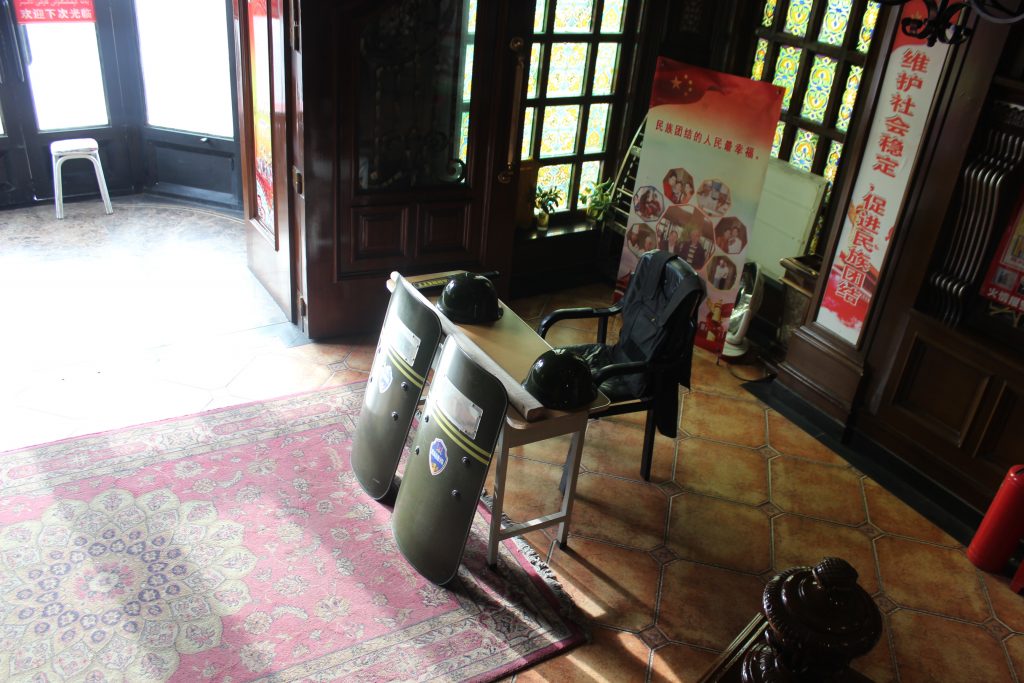
Another striking element is how they control the movement of people. Entry to any public place is strictly controlled. Residential compounds, markets, mosques, hospitals, and other wider spaces all have separate entries and exits. Inside both entries and exits, there is a metal scanner, an ID card reader, and in some (not many) places a facial recognition camera. Places which expect foreigners also have more advanced passport scanners. All places have a computer and a small box which is reportedly used to download all information from smartphones, which the protocol mandates if someone can’t produce their ID card. We were never asked to produce our phones, nor did we see it done to anyone else, but we did listen to many others saying that was the case, before and during the trip.
Every entrance also had two or three security guards, again with anti-riot gear. The Xinjiang authorities want to control who gets in and out of every place at every time. The assumption seems to be that a knife-wielding terrorist may come at any time, so everyone must be ready with shields and bats, which should be enough to handle a guy with a knife until the police can bring in more serious equipment.
I have no idea how bad the security situation was in Xinjiang before these new measures were adopted. The Uyghur riots in Urumqi in 2009 were reportedly extremely brutal, with dozens of stabbings across the city. But by the look of the present security apparatus, you would think the whole province had been like a Brazilian favela or American ghetto, swamped with criminal gangs who terrorize the population. Some friends back in Shanghai told me it was quite bad, with regular attacks on both government officials and civilians.
I don’t know how it was before, but I know how it is now. It’s basically impossible to commit violent crime in Xinjiang. A normal day will probably send you through at least half a dozen metal scanners and ID controls, from your home to your place of work, to any single establishment you visit. In the streets, you face ubiquitous police and dozens upon dozens of high-tech surveillance cameras. I call the system triple-layer because you are controlled through your phone (Xinjiang still uses 3G signals, not LTE, I wonder why), through the massive deployment of surveillance cameras and by police on the ground. They know everything.
Being a bad guy in Xinjiang has to be an extremely stressful life.
Being a good guy is annoying enough, but I guess you can get used to anything. The checkpoints aren’t too time consuming if you have a Chinese ID card and know the security guards from daily contact. At the checkpoints we visited, on the other hand, annoyed police or security guards struggled with the protocol on how to handle foreigners. Most places just asked for our passports, took a look, and let us through, sometimes asking which country we came from. A few guards didn’t want to deal with the hassle and just told us to bypass the metal scanner and get out of their sight. As everything in China, enforcement is sometimes spotty. But those were the exceptions; discipline in the surveillance apparatus was generally quite high.
We walked leisurely through the city, and while we attracted some attention, we were neither stopped, nor stared at, nor (I think) followed. We went to the Urumqi bazaars, which were quite nice, if an obvious tourist trap. They are located in the Uyghur quarter of the town. Amusingly, one of them houses a large Carrefour supermarket, which only sells halal food. They also sold lots of jade, exotic wood, animal skins, and the like.
A small walk through the Uyghur quarter gave us the first glimpse of this ethnic group. The older people, say over 40, wore traditional clothes and looked foreign. The men wore hats, the women covered their hair. A few men had long beards. We didn’t see any women covering their faces. The young men and women all dressed in modern, Western clothes, and didn’t cover their hair. The young men were all clean-shaven. The neighborhood also had a ridiculous amount of Chinese national flags. Every single building had half a dozen national flags, stuck to walls, doors, or storefronts. The message was clear. Whatever you may have in mind, you are in China, folks. Get used to it.
We took lots of pictures, with our phones and with cameras, and were generally left alone, with only one warning: don’t take pictures of police.
We then got a Didi (China’s Uber) to Xinjiang’s impressive provincial museum. Most impressive were the massive pictures of Xi Jinping in the entrance, alongside a red banner, saying “Under the Guidance of Xi Jinping Theory of Socialism with Chinese Characteristics for a New Era, Let Us Work Hard and Write the Xinjiang Chapter of the China Dream of the Great Rejuvenation of the Chinese Nation.” It’s all so tiresome. But again, that’s the new normal in China. In Xinjiang, it’s just five times more so.
We left the museum, satisfied at the objects on display. The Tarim Mummies are something. We then stopped for some coffee at a nearby modern shopping mall which houses a Burger King, among other international chains. Again, same routine. Separate entry and exit, manned checkpoint, you show your ID, get through the metal detector, open your bags or get a pat down, depending on the mood of the guard. We were already getting used to it. The coffee was good.
We decided to hit the bars in the belief that where people party is where you see the most authentic life of a city. That, and we needed a drink. We found a fancy-ish street with bars and restaurants. Most were packed with party-loving people, drinking alcohol by the case-load, just like in any other city in northern China. The vast majority of them were Han Chinese, but we could also tell there were Uyghurs in the bars, drinking and being merry. Urumqi is after all the home of the provincial government, which across China generally makes a point of employing many minorities, and we saw many rich and connected Uyghurs dressed in expensive clothes and drinking expensive wine.
If you’re the only foreigner in a bar in China, odds are that a bunch of people are going to approach you at some point in the night to try to show off their English, or genuinely start a conversation. We found the Xinjiang folk to be rather more reserved. After a change of venue, though, we did find people willing to chat. Some whined about the security policies, mentioning the need to surrender their passports to the police station and apply every time they need to use them. People from Xinjiang also often have trouble getting leases or staying in a hotel. One guy mentioned some news where Xinjiang residents were thrown out of a hotel in Shanghai because they were “Xinjiang people.” This wasn’t an ethnic thing; these were ethnic Han complaining. That didn’t surprise me. I know the Shanghainese well, and for them everyone from outside of Shanghai is some sort of orc.
The beers kept flowing, and we extracted some juicy details. Apparently, you are also supposed to tell your residential compound committee if you ever leave the province for any extended period of time, but we heard conflicting accounts on that. One person mentioned that people are put in a sort of special surveillance list, although most people are quite safe. After too many beers, I point blank asked if it was true that police would come in 30 minutes if I talked about politics on the phone.
I got weird looks after that, but the consensus seemed to be: “Nah, never heard of anything like it. Why would you do that anyway?” The conversation turned awkward, as people perhaps thought we were asking too many questions. But the general mood was pleasant. We all drank until late and went home without the slightest issue. Our group was coming from many places in the West where stumbling out of a bar late at night can often be quite dangerous. We had to admit that you feel safe at night in Xinjiang. Completely safe. As long as you don’t talk politics on the phone, I guess.
We spent another day in Urumqi walking around the city, enjoying the food and the scenery, getting in and out of taxis, being looked at by police and bystanders, but never disturbed. Then we decided to move on. Our next destination was Turpan, 150 miles southwest of Urumqi, south of the Tianshan mountains. Turpan also happens to be along the brand-new high-speed rail line that connects Urumqi to Lanzhou in Gansu province. The trip takes just one hour in the new, high-tech trains.
We got a taxi to the new Urumqi station, about 30 minutes from the city center. About 500 meters before the station itself there was a police checkpoint with a small building attached. Most people were waved through; some were made to open their car trunks and had their luggage inspected. We were completely stopped and told to get out of the car and into the building. The taxi driver looked half annoyed, half scared. Inside the buildings, police asked for our passports, took pictures of all relevant pages, and asked us, rather abruptly, what our business was. We explained, put our luggage through a scanner, and they let us go. We then got back on our taxi and went on to the station.
Inside the station, we lined up to go through another control. All train stations in China have luggage scanners and ID controls before getting into the hall of the station, so there is nothing unusual about this; Xinjiang just happens to have an additional layer before that. I assume that the police department in charge of the first layer is of a more serious sort.
Urumqi station is a new, huge building, built to accommodate the new high-speed rail line. The design is similar to every other new train station in China. You often get the impression that the train stations in China are needlessly big, but then you get inside and see them filled to the brim with people, and you start to thank the foresight of Chinese engineers. Urumqi was no exception. We didn’t get the chance to see the old station, now renamed Urumqi South, but we heard it has even more people but much less space.
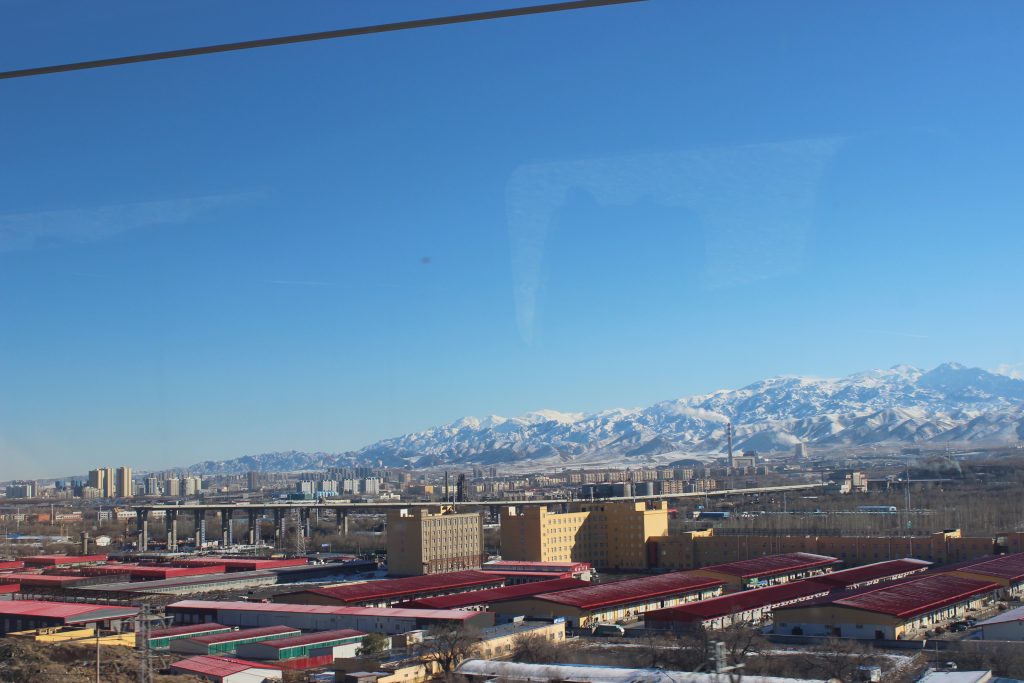
We got on the train to Turpan, enjoying the same flawless experience of high-speed rail as anywhere else in China. After one hour, with no delays, we arrived to Turpan’s new station, Turpan North. The old Turpan station is 20 miles north of the city, while the new one was built closer to it. Chinese train stations tend to be built like airports, not only in size, but also in distance from the city center. They tend to be quite inconvenient, especially if you’re used to European, Japanese, or Korean levels of convenience. But China doesn’t care about your comfort, only about getting things done. Which they do.
Turpan
Out of Turpan’s station, we were stopped by police at the exit. The station is built upon a hill, and right out of the station is a huge square, from which you can see down for a long distance, a huge expanse of nothing much. There are only two things of note in the square. One is an enormous picture of Xi Jinping with a bunch of Xinjiang school kids. Below it is inscribed: “The hearts of General Secretary Xi Jinping and the peoples of all nationalities of Xinjiang are united.” Police told us to come with them, so we couldn’t take a picture of that one. That the whole affair felt ominous is putting it mildly.
The one other thing in the square is, you guessed correctly, a police station. I forgot to mention that police stations in Xinjiang aren’t called “police stations.” In Chinese, that would be 公安局, public security bureau. The Xinjiang police apparatus has learned from modern PR manuals, and calls its ubiquitous police buildings, 便民警务站. An enterprising academic could write a whole paper with the fine Kremlinology or Zhongnanhai-ology of that phrasing, but a literal-ish translation would be “Police stations to serve the people.” After seeing dozens of police stations, we were going inside one for the first time on our trip.
Inside the station was a policewoman, in her 30s, who was very pleasant and rather pretty. She took our passports, asked what our business there was, where we were staying, for how long, etc. She took pictures of all our information, and let us go, wishing us a good time in Turpan. She also cautioned us not to take pictures of police.
Speaking of which, one of us traveling spent some time during the trip browsing the Chinese equivalent of Tinder and most amusingly found that there were many women on dating apps stating ‘police’ as their occupation. Whatever came out of that is not something that can be written for the public, but what we can say is that it shows the sheer amount of police personnel being employed in Xinjiang at present.
Turpan is entirely different from Urumqi. It is an 80% Uyghur town, and always has been. In Urumqi, you had to look closely to find an Uyghur; in Turpan, it was the other way around. It’s a rather small city, at least by Chinese standards. Turpan has an interesting history as a large oasis that is also somewhat close to China proper; it took advantage of its privileged location to be one of the most important Silk Road entrepots. Turpan is the home of two large-scale city ruins, the ancient cities of Jiaohe and Gaochang. It is also famous for its grapes, which are made into raisins (not into wine, alas). The locals are very proud of their raisins and tell you so all the time.
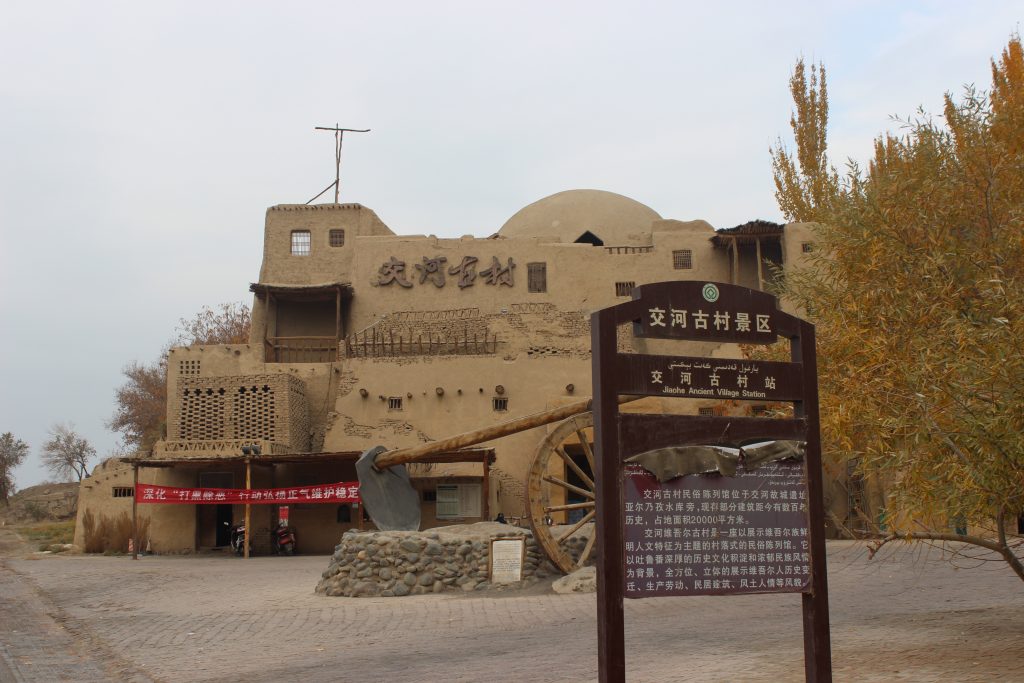
Our travel plan in Turpan was the same as in Urumqi: see the sights, but try to walk around the city as much as possible to get a feel of the place. Turpan is smaller than Urumqi, and is also less clean and orderly. The city was full of motorcycles and electric scooters, which are banned in Urumqi. That doesn’t mean they kept the old city; you can still see small sections of those mud and brick old house areas; but by and large they have been razed, and the city rebuilt upon a typical provincial Chinese plan, with wide avenues connecting walled-up compounds of apartment blocks. The old houses looked rather ghastly and badly built, but the Uyghurs seem to have a thing for doors, and even the shabbiest house tended to have a rather imposing door, decorated with beautiful patterns. It gave away the Middle Eastern heritage of the culture.

That said, Turpan is a tourist city; it gets millions of Chinese tourists every year who come to see the ruins and vineyards and to get a taste of exotic cultures close to home. As far as Chinese cities go, Turpan is quite pretty, with plenty of green, tasteful buildings, and charming styling in public goods such as street lamps and the like. Even some of the propaganda signs were pretty.
The same security apparatus we saw in Urumqi was there in Turpan, perhaps a bit more so. Police stations every 200 meters or so, police cars patrolling all the time, and metal scanners at every shop, manned by security guards armed with wooden bats and plastic shields. Cameras everywhere. Markets and other large venues had separate entries and exits with ID controls, etc. Same thing. All large compounds also had barbed wire above the walls to stop people from jumping in or out. No funny business in Xinjiang.
One big difference with Urumqi was that, again, most people were Uyghur. But the police were Uyghur, too. The people manning the checkpoints and the “convenience police stations,” and driving the patrol cars were all Uyghur. It’s worth emphasizing that whatever is happening in Xinjiang is not just an invasion by a foreign army hell-bent on annoying the locals. The locals are quite annoyed, indeed, but it’s their fellow tribesmen doing the grunt work. Or most of it, anyway. I must say that the Uyghur police we saw were more easy-going than the Han police we saw in Urumqi. More chill. Less zealous, you could say. At any rate, they never gave us a hard time, and we got plenty of smiles and easy treatment. We also got the feeling that most “police” were just hired weeks ago. There are just too many of them to be properly trained. It’s just a job, and most of them don’t really appear to like it. But they’ll go through the motions. That’s very Chinese, too.
We did get a chance to stroll around some residential compounds. We saw the same security controls, barbed wire, and strict controls of entry and exit, in addition to lots and lots of propaganda banners and documents, announcing this or that campaign against “evil elements” which threatened the security of the people. One document cautioned against “village bullies” and “two-faced people,” among other examples of bad apples that the security apparatus has identified for capture.

We saw a Han (maybe Hui?) policeman doing guard time in front of a residential compound. A bunch of middle-aged Uyghur men were chatting with him, in bad Mandarin, but in a cordial way, laughing and all. We didn’t catch the whole conversation, but it seemed the locals were trying to tell the guy to cut them some slack, while the policeman, with a big smile, told them he was just following orders and working for the security of everyone.
We walked into a more rural area in the outskirts of the city. A big white wall was painted with scenes of ethnic harmony. One scene said in very clear terms: No Illegal Religious Activities Allowed. No religious activities at all allowed in public places. Do not interfere with marriage, family planning, or education in the name of religion. Speaking of religion, we saw a few mosques, but many looked abandoned, or taken over by “local committees,” or Communist Party branches. No call to prayer. Certainly nobody praying. Islam has been extirpated from the public space. It’s hardly visible at all.
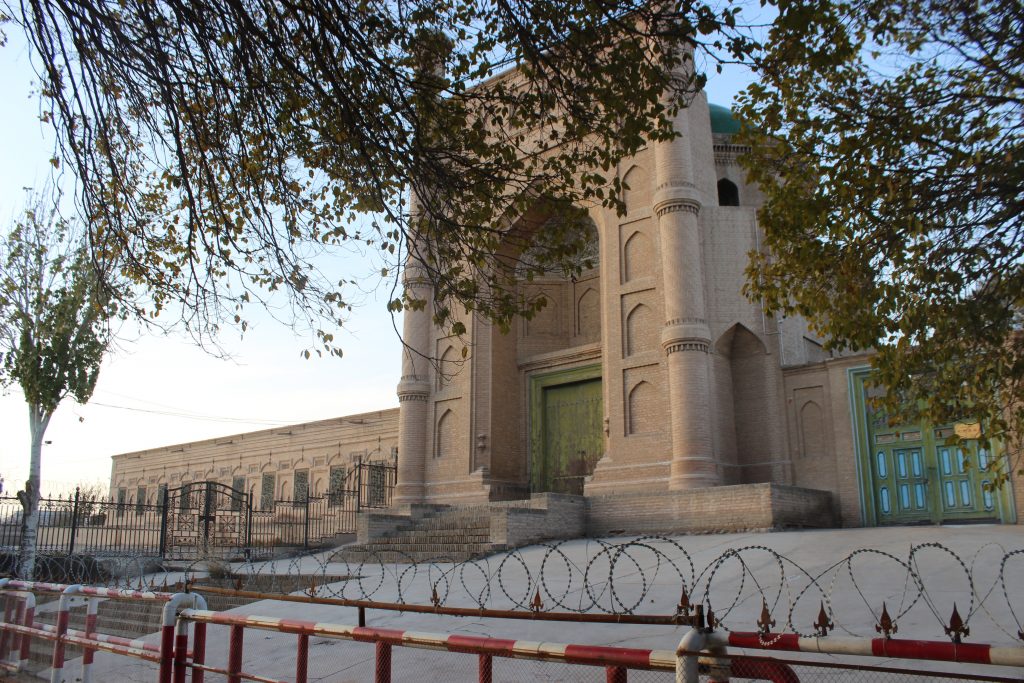
One other thing that is very visible in its absence. Young men. You see plenty of people in the streets: lots of children, lots of mothers of children, and many young women, especially running restaurants and small shops. Old people in their typical Uyghur garb, men with their hats and beards, and women with their head coverings. Oddly, many middle-aged ladies covered their hair, but wore high-heeled shoes. But very few young men. The ones we did see were the mellow kind, the sort of boy who was a good student in class. I’ve traveled extensively around the world, and everywhere you can see groups of strong, tall, young men just hanging around, sort of looking for trouble. Young men do that. Young men hanging around doing nothing but looking intimidating exist everywhere, including China, even Japan or Singapore. But not in Xinjiang. As for where they are, your guess is as good as mine. As one propaganda banner said, 幸福是奋斗出来的. Happiness comes from (vocational) hard work.
Also strolling around the residential compounds we were able to see the extent of government control over the population. Most houses and storefronts had a government-issued red plaque which said 平安家庭, Peaceful Household. Storefronts said Peaceful Shop. A few even had a plaque saying 优秀平安家庭, Excellent Peaceful Household. And a few didn’t have anything, so we could only assume they aren’t peaceful. I don’t know what these signs are about, although I guess it’s about a history of cooperation with law enforcement. The streets also had signs speaking of team leaders; all the households in Xinjiang are arranged into teams of 10 or so, led by a “team leader” who rotates once a month, in what seems to be a crafty collective responsibility system. The team leader gets “four micropowers,” among them issuing household subsidies and recording the registration of visitors. Most importantly, that team leader has to check on people’s respect for the law, or lack thereof. If anything goes wrong, the team leader is responsible, so everyone takes care that nobody does anything stupid.
All houses also had a blue plaque with a QR code, supposedly for police to get all relevant information at a glance. Every now and then you saw a 报警点, “call police spot” with a 4-digit number. It seems that if you need to call the police, you give them that number, instead of a long-winded street address. You really get the impression that the police pretty much runs the province, and they’ve made sure that they can change the urban landscape to make their jobs easier. Police in the West, or any other country really, would give an arm and a leg to have the sort of facilities that Xinjiang police have access to.
The sheer amount of committees and groups and campaigns and awards and social stuff that the government is applying in Xinjiang reminds one of Maoist China in the 1950s and 1960s. For all its failures, one thing that Maoism and Soviet policy in general were able to succeed at was practically disabling the influence of Islam in people’s lives. It did it through repression, but also by crowding out, by filling people’s lives with non-Islamic activities until they lost their traditional culture. That seems to be the approach China has decided to take in Xinjiang to deal with Islamic extremism, and it fits with the general approach of Chinese politics since Xi Jinping became president: to retake the cultural influence of the government by using tried-and-true Maoist techniques, aided by new technology.
West to Kashgar
Out of Turpan, we mostly took trains to the West; I’ll spare you the details. There’s not a lot to see out there, and the basics of the new surveillance system are the same everywhere: propaganda, police, checkpoints, and cameras. The same policy everywhere, enforcement more or less enthusiastic, but reasonably serious wherever you go. Checkpoints were sometimes short, sometimes long, but mostly involved long looks at our passports, as if they’d never seen one. One guy I’m pretty sure had never seen a passport, and he spent a whole half an hour looking at it. Some hotels gave us trouble, saying that journalists couldn’t stay. Good thing we’re not journalists, and once we made that clear, we were good to go. Lesson one for traveling in Xinjiang: don’t be a journalist. But that’s good advice everywhere. Don’t be a journalist, folks.
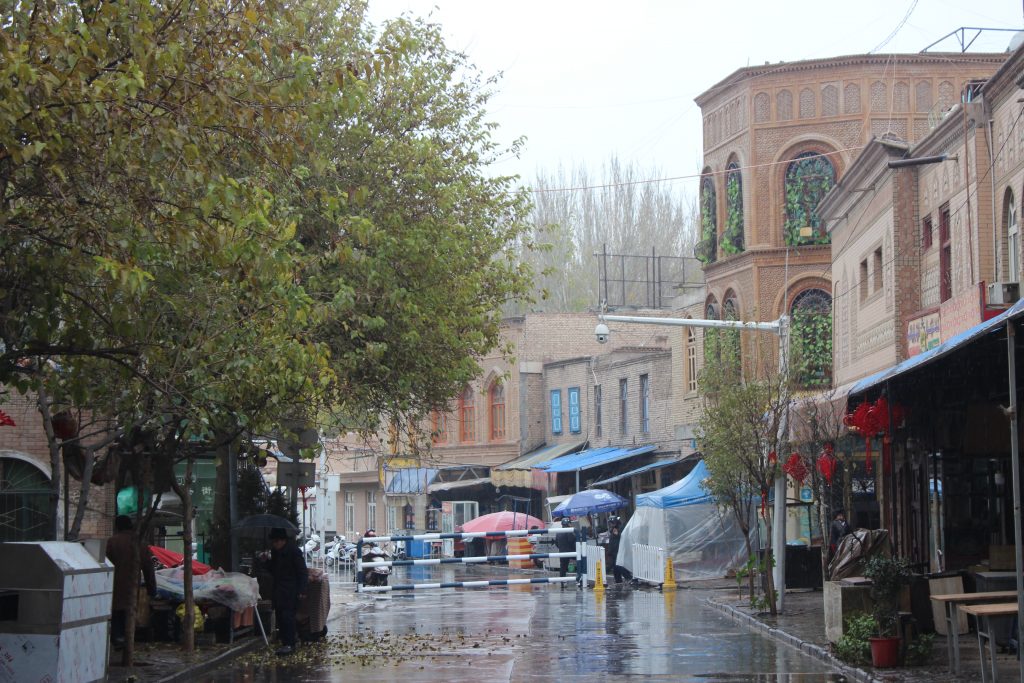
We didn’t run into checkpoints out of train stations, but we did while driving on highways. There’s nowhere to hide in Xinjiang. In these big checkpoints, they also had big personal scanners, similar to what some airports use now, called Terasnap. Those sell for $250k on Alibaba, so someone is making a lot of money. We also saw middle-aged Uyghurs getting their phones checked, thoroughly. We wondered if the Uyghur police checking people out all the time were hired in place, or shuffled around from other cities. Disallowing government to serve in their hometowns is a very old Chinese tradition, so it would make sense if, say, the police in Kashgar were from Turpan, and vice-versa.
After a few days of mostly pleasant traveling, we arrived in Kashgar. In the Western edge of the Tarim Basin, close to the Pamir mountains which separate it from Central Asia, Kashgar has traditionally been the cultural center of the area. And it shows. It’s a large, wealthy city. The old city has been reportedly mostly razed, but the Chinese government has kept part of it as a tourist spot, the Kashgar Old Town. China does that all the time with minority old towns, such as in Lijiang or Dali; they set up a part of the old city as protected, and keep the population in place. Tourists thus get to not only see the architecture of the old town, but also the original inhabitants just going through their daily lives inside it. It’s somewhat fake, many buildings being of recent construction, but not totally fake. People do live there, operate their shops or whatever, the kids go to school, and go back to their homes. The Kashgar Old Town is beautiful and pleasant to walk through. Watching school kids come back from school and just walk around without fear of cars or even bicycles felt like an urbanism lesson made real.
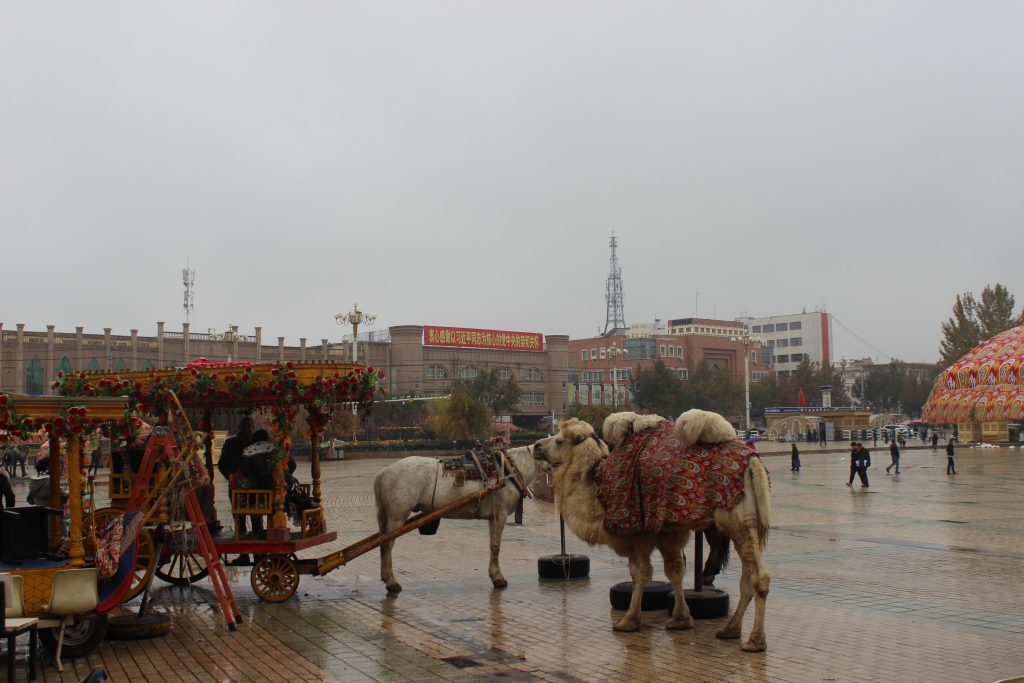
Kashgar being closer to Baghdad than to Beijing, the people look noticeably different from Uyghurs further East, slightly more Caucasian. Big, expensive restaurants seem to be a preferred gathering place for Uyghurs. They are decorated in very sumptuous Persian style, with blinds over all windows. Xinjiang police know about them, so if they want to keep things private by blocking the windows, they have to have surveillance cameras inside the restaurants. And Chinese flags. And propaganda banners. Just in case you are into any fishy business while eating your kebabs, which by the way are the best we’ve ever eaten. Lamb in Xinjiang is delicious, and worth a trip just to taste it. The bread is great, too. And the baked dumplings are out of this world. I miss Xinjiang, even with its police, cameras and all.
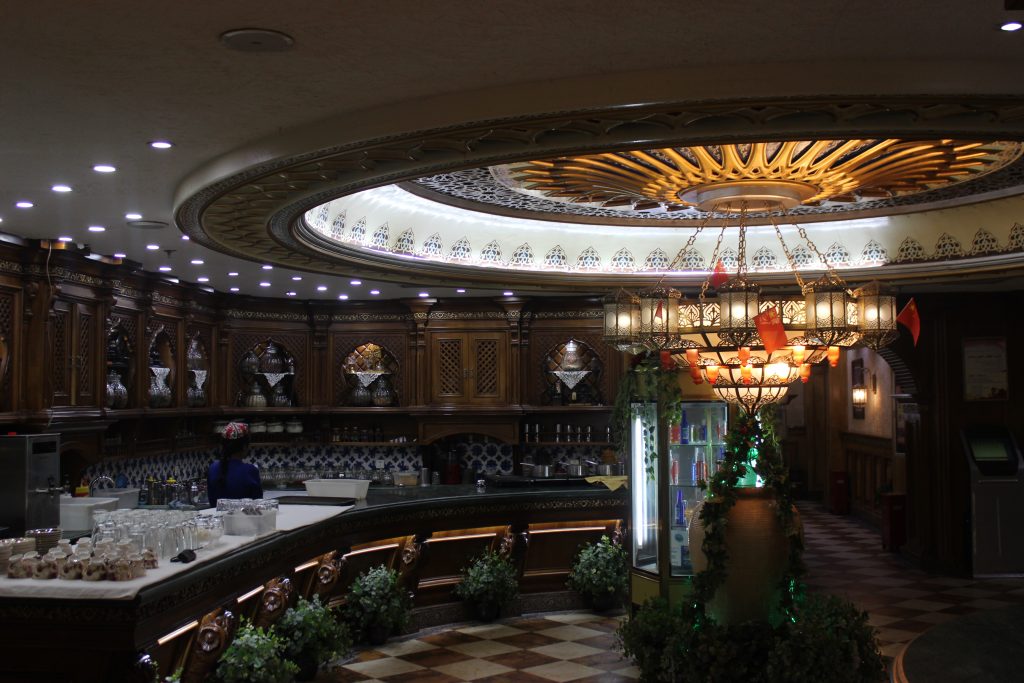
Walking through the old town, an old man selling jade stones and other antiquities waved us to come in. We didn’t get talked to much at all during the trip (people were obviously wary of raising suspicion), so we gladly went into the store. The man then reached into a drawer and took a picture. I was wondering if he was going to try and pass off a message to a family member out of the country. But I watch too many movies. Or maybe I read The New York Times too much. The old man brought a picture of his son in military uniform. In broken English, he told us how proud he was of his son, who had made it to the People’s Liberation Army. There was nobody else in the store, and no cameras, so we assume that was spontaneous. We congratulated him and left, without buying his jade stones.

Soon afterwards, we saw a military recruitment campaign poster, close to the Kashgar Bazaar, written in Uyghur. We also saw “special police,” basically police officers who get to carry guns. All of them Uyghurs. China has no problem arming Uyghurs, or even getting them into the military. They trust their loyalty, or at the very least they trust the mechanisms they have in place to ensure their loyalty.
We were surprised when we got on a taxi, which tends to be a stressful experience in Kashgar, as Mandarin levels are very low. Turpan was great; everybody spoke quite good Mandarin. But not a single Kashgarian we met outside the hotel spoke much Mandarin at all. Taxi drivers were no different, and it wasn’t easy to be understood. In these circumstances, we were quite amused to see that one of our rides had a small picture of Xi Jinping hanging down of his back mirror. China has always been big in conspicuous shows of loyalty, but a Kashgar taxi driver having a picture of Xi Jinping in the place where, say, an Italian driver would have a picture of the Virgin Mary, was a bit much. Oh, and of course all taxis have large surveillance cameras inside them.
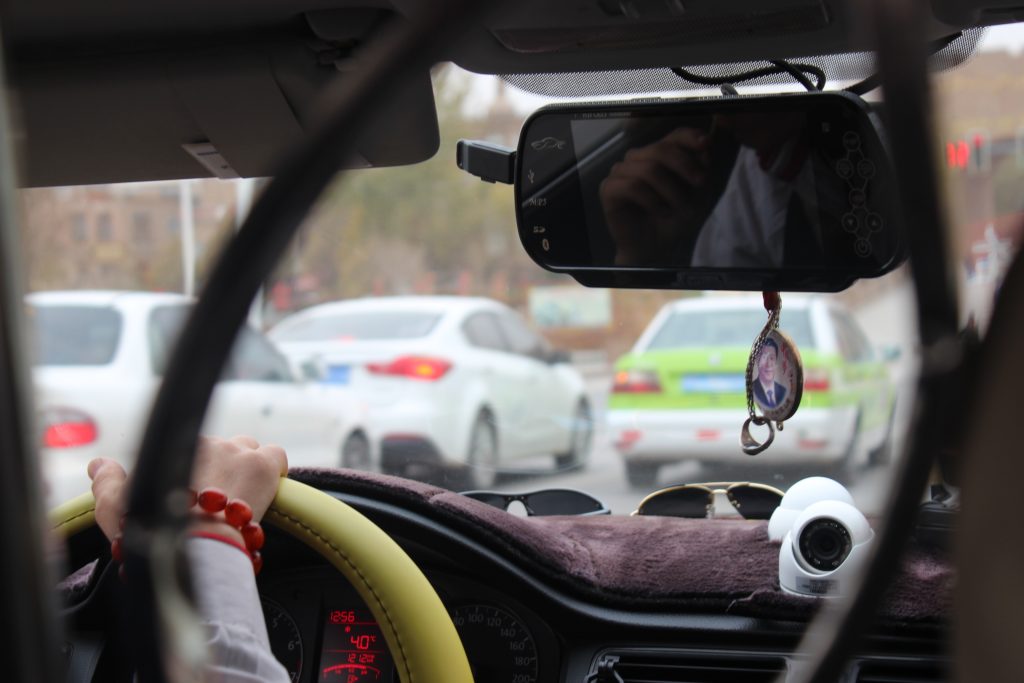
Regrettably, Kashgar and all the majority Uyghur towns didn’t have much of a bar scene. The Uyghurs don’t really drink, and Kashgar only had a handful of bars in the Han part of town. They got the job done; but the grand project of bringing the joys of modern Chinese culture to the Tarim basin seems to be faltering in one important part. Then again, getting the Uyghurs hooked on alcohol might not be a great idea just yet.
And so our trip ended; we all flew away from Kashgar back to our respective homes. We weren’t stopped before leaving. We had been expecting some police visit to our hotels for the whole trip; but nothing happened. Then again, we didn’t do anything suspicious, either. We did not try to explore the deepest countryside, or take pictures of the reeducation camps, or seek politically active people. The sole purpose of our trip was to visit Xinjiang, and if possible to get a feel of how it is like to live in Xinjiang today for your average person, of any ethnicity. It goes without saying that we left with mixed feelings. We saw life under a complete, multi-layered surveillance system that has basically no blind spots at all. A system which has dialed back the clock in most non-urban areas, bringing back old-school Soviet practices of social control. It is jarring and oppressive in many ways; and as foreigners we surely didn’t get to experience most of it.
Yet again, the Chinese government congratulates itself in having solved terrorism without war, and credit where it’s due, it has. Xinjiang appears to have no criminality whatsoever, and the police in the streets are unarmed. .
Islamic extremism is a problem around the world. Even setting aside civil wars like Algeria or Syria, Islamic extremism has killed thousands in the West, sometimes in spectacular orgies of violence like the Bataclan massacre in Paris. The liberal world has been trying for decades to find a solution to this problem, unsuccessfully. China has found one: communism. Just plain old Soviet-style Communism with high-resolution cameras and a strong IT infrastructure. The core of it is just plain old communist control of the populace, and ideological overload to maintain cultural dominance.
I don’t think we have much to learn from it; the West is, thankfully, just not communist. Even if we wanted to, we in the West don’t have the administrative mechanisms to do anything like this. Xinjiang is just applying the same stuff that has always existed in China, just stronger. Much stronger, but the core administrative mechanisms were already there. Government innovations are almost always incremental.
A big question is if the Xinjiang model will ever be brought to China proper. It’s not inconceivable, but I’m skeptical. For one, it’s just too expensive. China would need tens of millions of police to get the same sort of coverage over its whole population. And the Chinese are not as meek as they’re often made to be. There’s already been effective push back against many attempts at smartphone surveillance in universities. Crime in China is quite low already, so there’s not much of a rationale to increase surveillance in ways that inconvenience people to that extent.
When you travel to Xinjiang, you’re going to a region where there’s business to be done and where the stakes are high. The entire surveillance system is part of this larger strategy for dominance. The landscapes are breathtaking, but the Chinese apparatus isn’t there for the sights. The region is its diving board into Central Asia, and its work will continue apace. Like it or not, it’s part of the post-liberal world that is coming. Perhaps an important one.
Xinjiang is a perfectly pleasant holiday destination. It’s a good place. The posters will tell you so.
